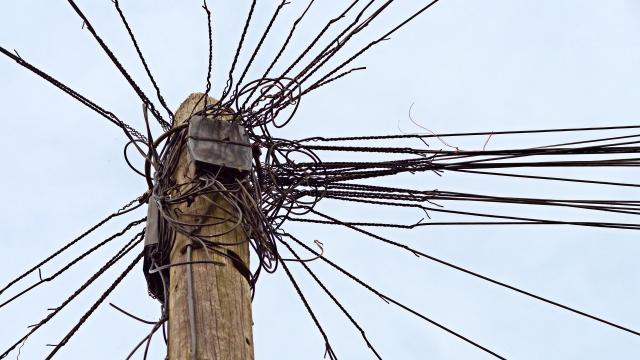Twitter is reportedly testing a feature on its Android app that would automatically reformat large blocks of text into long self-reply threads, or tweetstorms. This would ruin Twitter, which has already been ruined multiple times by new features.
Photo by aitoff
Past Twitter-ruining features include GIPHY integration, which encourages mediocre GIF responses that turn a viral tweet’s replies into a wall of samey celebrity animations. A heightened reply limit lets users drag a dozen strangers into an unwanted public thread; group DMs let spammers drag a dozen strangers into an unwanted private thread. Quote-tweeting turns the timeline into a “look at this stranger’s bad tweet” wall of shame. The algorithmic timeline makes conversation around live events (Twitter’s killer app) incoherent; hashtags try to fix that, but instead they make normies write like robots in hopes of gaining a hundredth follower.
[referenced url=”https://www.lifehacker.com.au/2017/03/what-to-do-when-you-get-stuck-in-a-twitter-reply-allpocalypse/” thumb=”https://i.kinja-img.com/gawker-media/image/upload/t_ku-large/dj6mcmlei3nzwic9c708.png” title=”What To Do When You Get Stuck In A Twitter Reply-Allpocalypse” excerpt=”Twitter just added a new feature that lets you add a seemingly infinite number of people to a conversation without affecting the 140 character limit. You can, essentially, @ everyone at once. It’s fine when it’s just a few people tweeting back and forth, but more annoying tweeters can take advantage of the feature and blow up your notifications.”]
The moments tab is condescending; the reporting feature is half-assed and easily abused, as is banning; notifications include useless information such as “someone liked a reply to you.” Likes were better as faves. Live-updating reaction counts are distracting; lists are awkward; self-replies mean tweets move around in your timeline as you’re trying to read them; multi-user threading is impossible to parse now so everyone thinks they’re being insulted by their own team. Verification carries functional benefits and status, and yet it’s handed to Nazis when they get un-banned.
Matt Navarra, director of social media at The Next Web, credits screencaps of this new potentially Twitter-ruining feature to someone named “Devesh Logendran”, whom he’s also credited for shots of several alleged upcoming Facebook features. Twitter declined to comment about the supposed feature. But such a feature would not be out of character for a service constantly reinventing how to ruin itself.
WOAH! Twitter has a hidden tweet storm feature!
h/t Devesh Logendran pic.twitter.com/QpDLhKnAZZ
— Matt Navarra ⭐️ (@MattNavarra) September 10, 2017
While I’m not against tweetstorming, and have in fact encouraged it, there are certain strategies to it, and certain difficulties. How someone approaches these difficulties provides crucial context for the value of the tweetstorm. The US president, for example, rarely manages to thread his own tweetstorms.
[referenced url=”https://www.lifehacker.com.au/2017/06/tweetstorm-without-embarrassing-yourself/” thumb=”https://i.kinja-img.com/gawker-media/image/upload/t_ku-large/iybhhnlkikoirgcuxpqs.jpg” title=”Tweetstorm Without Embarrassing Yourself” excerpt=”In 2016, after killing blogs dead, Twitter considered massively expanding its character limit — or, more precisely, allowing users to attach long blocks of text the way they can attach pictures or videos. This never came to pass, and Twitter users kept shoehorning essays into self-reply threads called tweetstorms.”]
Context clues abound. Does the user know how many tweets they will send? Does the hundredth tweet deliver on the promises of the first, or does the thread spill out, like over-noticed political consultant Eric Garland’s, into a rambling mess? Does the writer compose each tweet as a standalone unit, fit for retweeting, or do they break off in the middle of sentences, proving that they should have put their rant on Medium instead, but chose Twitter because they’re desperate to have every sentence liked?
Under the model depicted in TNW‘s screenshots, these signifiers would disappear. Twitter, says TNW, would automatically split a block of text into multiple tweets, then attach a clean parenthetical count to each. The storm would approach and dump its contents, just a long essay poorly broken up into tweets, calling attention to just how weird and dumb a tweetstorm can appear, while simultaneously wiping away the organic markers of the writer’s unhinged approach.
Of course, users will always have the choice to tweetstorm the old-fashioned way. The real danger is what new horrors the users will achieve with the feature. Most of the existing features only ruined Twitter because of their unintended consequences. What can spammers, hoaxers and Nazis achieve with this new tool? Probably more than the well-behaved users, who just want a nice place to put one sentence at a time. (1/520)

Comments